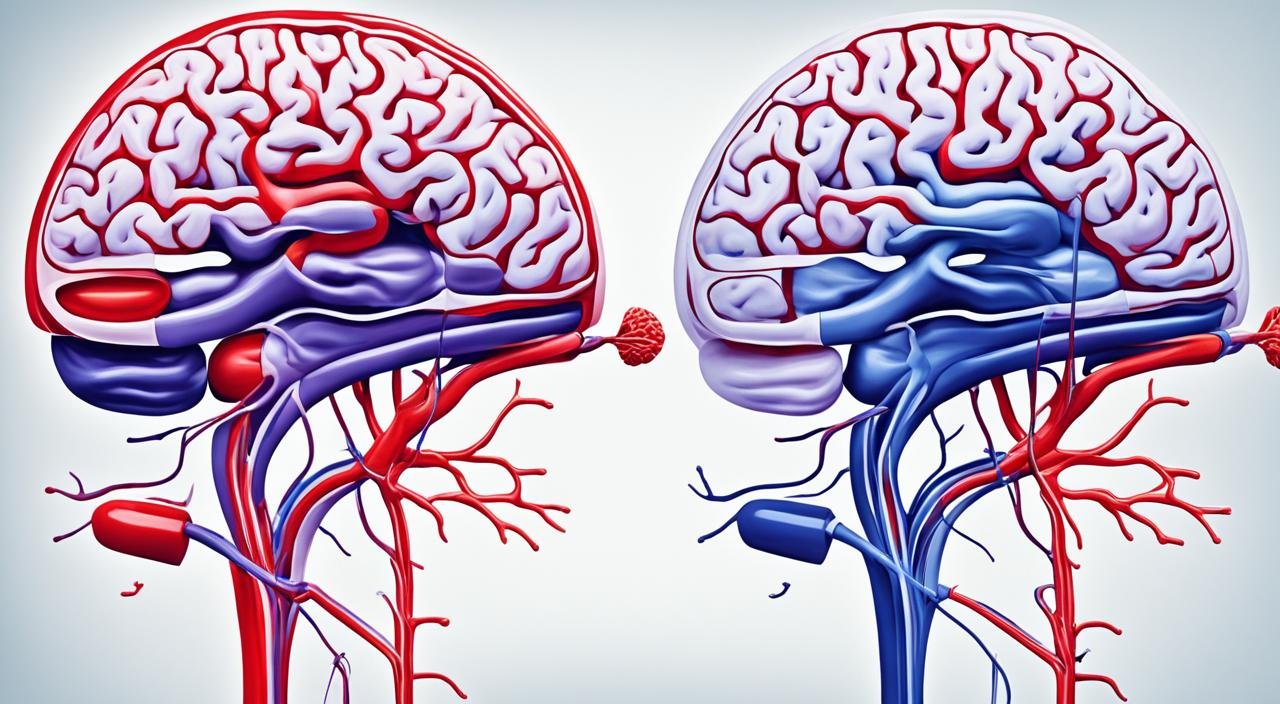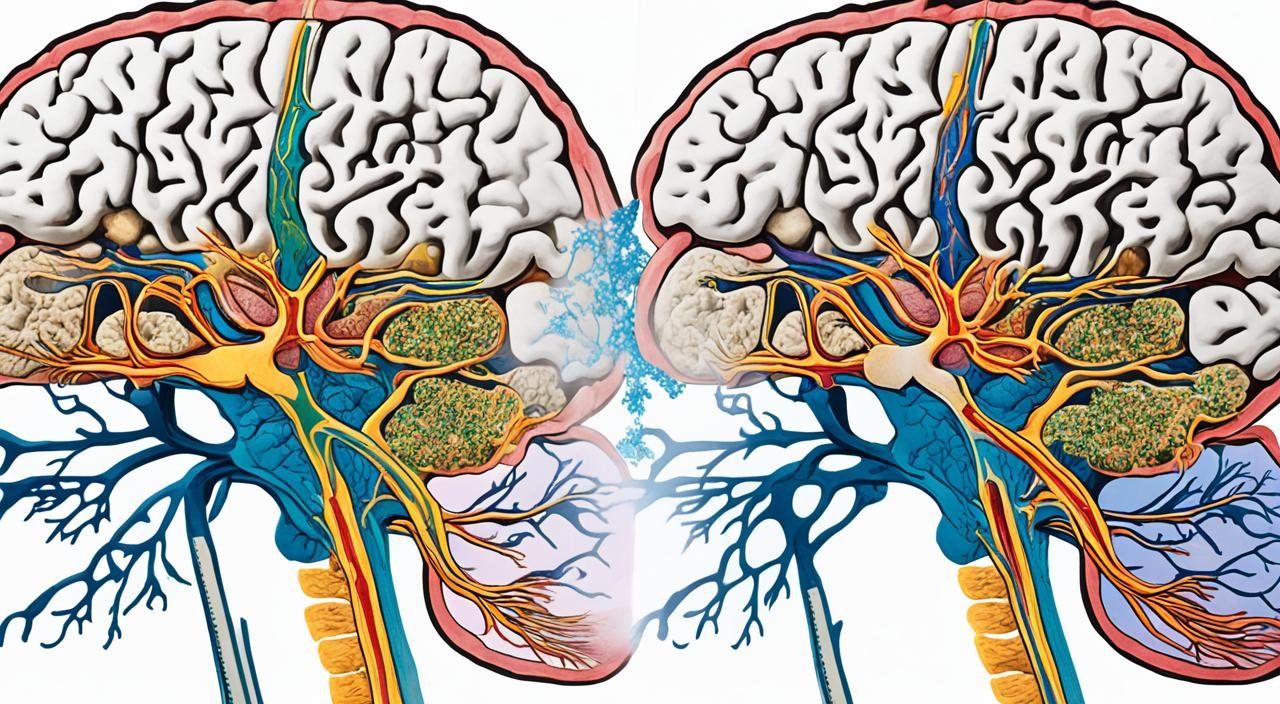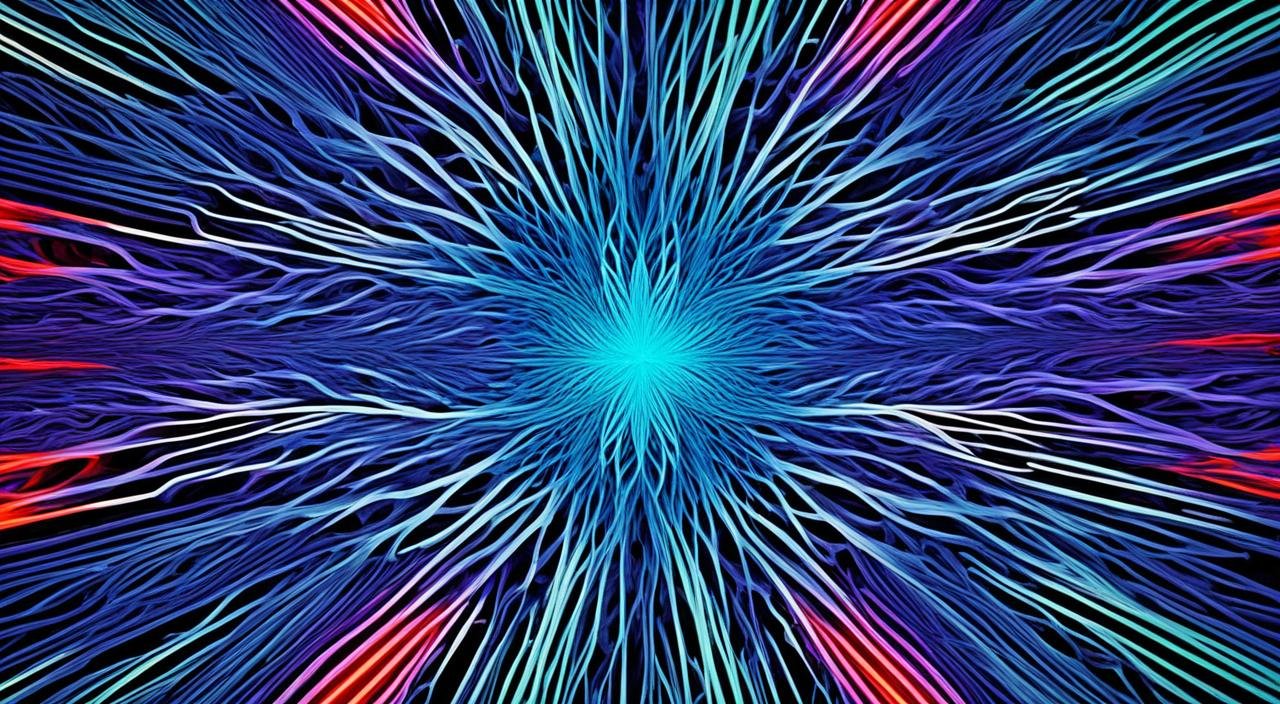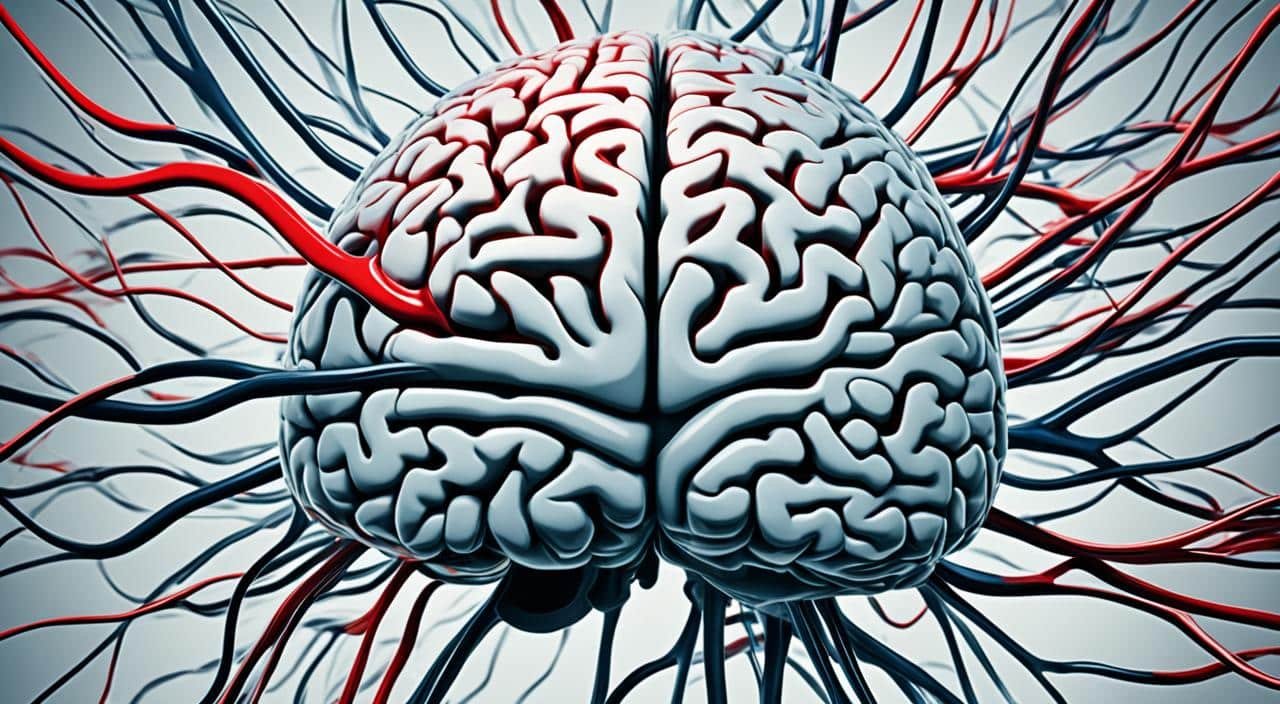Strokes are divided into two main types: ischemic and hemorrhagic. Ischemic strokes happen when a blockage stops blood flow to the brain. They make up about 87% of all strokes. Hemorrhagic strokes, which are less common, occur when there’s bleeding in the brain and account for around 13% of strokes.
There are more stroke types beyond these two. These include transient ischemic attacks (TIAs), also called mini-strokes, and brain stem strokes. Cryptogenic strokes, which have no known cause, are another type. If someone has had a stroke before, they might experience recurrent strokes, which are a big concern.
Key Takeaways
- Strokes can be classified into two main types: ischemic and hemorrhagic.
- Ischemic strokes are the most common, accounting for around 87% of all strokes.
- Hemorrhagic strokes make up approximately 13% of all stroke cases.
- Other types of stroke include transient ischemic attacks (TIAs), brain stem strokes, and cryptogenic strokes.
- Recurrent strokes, where a person experiences multiple strokes, are a serious concern.
Understanding Stroke: A Medical Emergency
A stroke is a critical medical emergency. It happens when the blood flow to part of the brain stops. This can be due to a blood clot (ischemic stroke) or a burst blood vessel (hemorrhagic stroke). If not treated quickly, brain cells die, causing permanent damage and disability.
What is a Stroke?
A stroke is a serious condition where the brain doesn’t get enough blood. This can be from a blocked artery (ischemic stroke) or a bleeding blood vessel (hemorrhagic stroke). Without oxygen and nutrients, brain cells die, leading to lasting harm.
Warning Signs of Stroke
Knowing the signs of stroke and acting fast is key. Early treatment can greatly improve recovery. The acronym F.A.S.T. helps remember the main signs:
- F – Face drooping
- A – Arm weakness
- S – Speech difficulty
- T – Time to call 911
If you or someone near you shows these symptoms, call 911 right away. Fast action can save a life and lessen the stroke’s effects.
Ischemic Stroke

Ischemic strokes are the most common type of stroke, making up about 87% of all cases. They happen when a blood clot or blockage stops blood flow to the brain. This means brain cells don’t get the oxygen and nutrients they need.
Symptoms of Ischemic Stroke
The signs of an ischemic stroke can change based on where and how bad the blockage is. But, they might include:
- Sudden numbness or weakness in the face, arm, or leg, often on one side of the body
- Confusion, trouble speaking, or difficulty understanding speech
- Sudden trouble seeing in one or both eyes
- Sudden trouble walking, dizziness, loss of balance, or lack of coordination
- Sudden severe headache with no known cause
Causes and Risk Factors of Ischemic Stroke
Ischemic strokes often come from a buildup of plaque, or atherosclerosis, in the arteries that feed the brain. This plaque can cause blood clots, which can then block blood flow to the brain. Things that increase the risk of getting an ischemic stroke include:
- High cholesterol
- High blood pressure
- Diabetes
- Obesity
- Smoking
- A history of previous strokes or transient ischemic attacks (TIAs)
Knowing the signs and risks of ischemic stroke helps with quick action and treatment. This can greatly improve the chance of survival and recovery.
Also Read :How Do I Reduce My Cancer Risk?
Types of Ischemic Stroke

Ischemic stroke is the most common stroke type. It happens when a blood clot blocks a brain artery. This cuts off oxygen and nutrients to the brain. There are different types of ischemic strokes, each with its own cause and features.
Thrombotic Stroke
A thrombotic stroke is caused by a blood clot in a brain artery. This clot, or thrombus, forms from fatty deposits in artery walls. Over time, these deposits narrow the artery, making it prone to clotting.
Embolic Stroke
An embolic stroke happens when a clot travels from the heart to a brain artery. These clots can break off from a larger clot or form with irregular heart rhythms. Atrial fibrillation is a common cause.
Lacunar Stroke
Lacunar strokes affect small, deep brain blood vessels. They are more common in people with diabetes or high blood pressure. These conditions can damage small arteries over time.
Knowing the different types of ischemic strokes helps doctors treat and prevent them better. They can tailor their care to improve outcomes and lower the chance of another stroke.
Also Read :How Does Coronavirus Impact Pets?
Hemorrhagic Stroke
Hemorrhagic strokes are a type of stroke that happens when bleeding occurs in the brain. This bleeding can happen inside the brain or between the brain and the skull. It’s important to know the causes and risk factors to spot and treat this emergency quickly.
Causes and Risk Factors of Hemorrhagic Stroke
High blood pressure, being over 65, having had a stroke before, bleeding disorders, and conditions that weaken blood vessels are main causes. These include aneurysms or arteriovenous malformations (AVMs). High blood pressure usually leads to bleeding inside the brain. A burst aneurysm or AVM can cause bleeding in the space between the brain and skull.
Types of Hemorrhagic Stroke
There are two main types of hemorrhagic strokes:
- Intracerebral hemorrhage (ICH): Bleeding directly within the brain tissue, often caused by high blood pressure.
- Subarachnoid hemorrhage (SAH): Bleeding in the space between the brain and the skull, usually due to a ruptured aneurysm or AVM.
| Type of Hemorrhagic Stroke | Cause |
|---|---|
| Intracerebral Hemorrhage (ICH) | Uncontrolled high blood pressure |
| Subarachnoid Hemorrhage (SAH) | Ruptured aneurysm or arteriovenous malformation (AVM) |
Both types of hemorrhagic strokes need quick medical help. This can prevent serious complications and long-term brain damage.
Also Read : What Are The Types Of Business Insurance?
Transient Ischemic Attack (TIA) or Mini-Stroke
A transient ischemic attack (TIA), also known as a “mini-stroke,” is a brief blockage of blood flow to the brain. This blockage doesn’t last long, usually fixing itself within 24 hours. But, it’s crucial to pay attention to it because it might warn of a bigger stroke to come.
Symptoms of TIA
The signs of a TIA are like those of a stroke but less severe and shorter. Common symptoms include:
- Numbness or weakness in the face, arm, or leg, especially on one side of the body
- Sudden confusion, trouble speaking, or difficulty understanding speech
- Sudden trouble seeing in one or both eyes
- Sudden trouble walking, dizziness, loss of balance, or lack of coordination
- Sudden severe headache with no known cause
These symptoms, though they don’t last long, are serious. They might mean you’re at risk for a stroke later. It’s key to get medical help fast. Quick action can stop a worse stroke from happening.
“A transient ischemic attack (TIA) is a warning sign that a more severe stroke may be imminent. It’s important to take the symptoms seriously and seek medical care right away.”
Also Read :What Are The Benefits Of Pet Insurance?
Brain Stem Stroke

A brain stem stroke is a serious emergency. It happens when blood flow to the brain stem stops. This area is key for breathing, blood pressure, and staying awake.
Symptoms of Brain Stem Stroke
Brain stem stroke symptoms can be tough. People might feel dizzy, have trouble balancing, or see double. In bad cases, they might not be able to move or speak but stay awake.
Causes and Risk Factors of Brain Stem Stroke
Strokes in the brain stem can come from blood clots or bleeding. Rarely, sudden neck movements can also cause it. High blood pressure, high cholesterol, diabetes, smoking, and not moving much increase the risk.
| Causes of Brain Stem Stroke | Risk Factors for Brain Stem Stroke |
|---|---|
|
|
Recognizing symptoms early and getting quick medical help is key. It can help lessen the effects of a brain stem stroke. This includes preventing locked-in syndrome.
Also Read :What Foods Should You Avoid With High Blood Pressure?
Cryptogenic Stroke

A cryptogenic stroke is a mystery in medicine. It happens when doctors can’t figure out why a stroke occurred. These strokes make up about 40% of all ischemic strokes. They leave doctors puzzled about why the brain’s blood vessels blocked or ruptured.
Even with lots of tests, like imaging scans and blood work, doctors can’t find the cause. The mystery of cryptogenic strokes stays unsolved. They keep looking for answers but can’t find them.
Figuring out cryptogenic stroke is key to better treatments. Researchers look at many things, like genes and heart issues. They hope to find out why these strokes happen.
“Cryptogenic stroke is a frustrating diagnosis, as it leaves patients and their families seeking answers that can be difficult to find. But researchers are dedicated to unraveling this mystery, for the sake of improving outcomes for those affected by strokes of unknown cause.”
The medical world is still trying to understand cryptogenic stroke. Patients and their families know that finding answers is important. Every new discovery helps us get closer to better care for these patients.
Recurrent Strokes

Having a stroke is a major health emergency. For some, it’s not just one event. Recurrent strokes happen when someone has more than one stroke. Studies show that about 1 in 4 people who have had a stroke will have another one within 5 years.
The risk of having another stroke is highest right after the first one. But, it gets lower over time. Yet, each subsequent stroke raises the chance of serious disability or death. It’s vital to manage this risk with the right treatment and lifestyle changes.
| Timeframe | Risk of Recurrent Stroke |
|---|---|
| Immediately after first stroke | Highest |
| 5 years after first stroke | 1 in 4 people |
| Over time | Decreases, but each recurrent stroke increases the risk of disability and death |
To lower the chance of recurrent stroke, it’s key to work with healthcare providers. They can help manage the causes, guide treatments, and suggest lifestyle changes for better heart health.
“Recurrent strokes are a serious concern, but with proper management and vigilance, the risk can be reduced. Each person’s situation is unique, so it’s crucial to work closely with healthcare professionals to develop an effective plan.”
Stroke
Strokes are emergencies that need fast action. Knowing the symptoms and acting quickly can help reduce brain damage. Treatment depends on the stroke type but often includes medicines, surgery, and rehab.
Ischemic strokes happen when a blood clot blocks a brain artery. These strokes need quick action to clear the clot and save brain cells. Hemorrhagic strokes occur when a brain artery bursts, causing bleeding. These may need surgery to stop the bleeding and ease pressure.
Every minute counts with strokes. Brain cells start dying without blood flow. Spotting signs like sudden weakness or trouble speaking is key. Calling for help quickly can greatly improve recovery chances.
After the initial treatment, rehab is crucial. Stroke survivors need therapy to regain skills and become independent. With a team of healthcare experts, they can learn new ways to live and lower stroke risks.
Stroke is a tough condition, but early action and rehab can lead to great recoveries. Knowing the signs and getting medical help fast can lessen stroke’s effects.
“The first few hours after a stroke are the most critical for treatment and can make a significant difference in a person’s recovery and long-term outcome.”
Also Read: Nuclear Medicine Technologist Career Guide
Conclusion
Strokes are complex and have different types, each with its own causes, symptoms, and treatments. It’s important to know the differences to spot the warning signs early. Quick action is key to better outcomes and lowering the chance of more strokes.
Strokes can be very serious, but thanks to new treatments and rehab, there’s hope for those who have them. By learning about stroke types, people can lower their risk and prevent future strokes. This guide has covered the main types of stroke and how to deal with them.
By being alert and tackling stroke risk factors, people can protect their brain health. With ongoing research and new stroke care, the future looks promising. This means more effective ways to prevent and treat strokes, helping people manage their risks and focus on their health.
FAQs
Q: What are the signs and symptoms of a stroke?
A: Common signs and symptoms of a stroke include sudden numbness or weakness, especially on one side of the body, sudden confusion or trouble speaking, sudden trouble seeing in one or both eyes, sudden severe headache, and difficulty walking or loss of balance.
Q: How can you prevent a stroke?
A: You can reduce your risk of stroke by maintaining a healthy lifestyle, managing high blood pressure, not smoking, staying physically active, and eating a healthy diet low in saturated fats and cholesterol.
Q: What are the types of stroke?
A: There are two main types of stroke: ischemic stroke, which occurs when a blood clot blocks a blood vessel in the brain, and hemorrhagic stroke, which happens when a weakened blood vessel ruptures and bleeds into the brain.
Q: What are the risk factors for stroke?
A: Some common risk factors for stroke include high blood pressure, smoking, diabetes, high cholesterol levels, obesity, atrial fibrillation, and a family history of stroke.
Q: What are the effects of a stroke?
A: The effects of a stroke can vary depending on the severity and location of the brain damage but commonly include paralysis or weakness on one side of the body, difficulty speaking or understanding speech, and problems with memory and thinking.
Q: What is the best way to reduce the risk of stroke?
A: The best way to reduce the risk of stroke is to make healthy lifestyle choices such as exercising regularly, eating a balanced diet, maintaining a healthy weight, managing stress, and avoiding excessive alcohol consumption.
Q: How is a stroke treated?
A: Stroke treatment may include medications to dissolve blood clots, surgery to repair blood vessels, rehabilitation to regain lost skills and abilities, and lifestyle changes to prevent future strokes.
Source Links
- https://www.webmd.com/stroke/types-stroke
- https://www.hopkinsmedicine.org/health/conditions-and-diseases/stroke/types-of-stroke
- https://www.stroke.org/en/about-stroke/types-of-stroke




